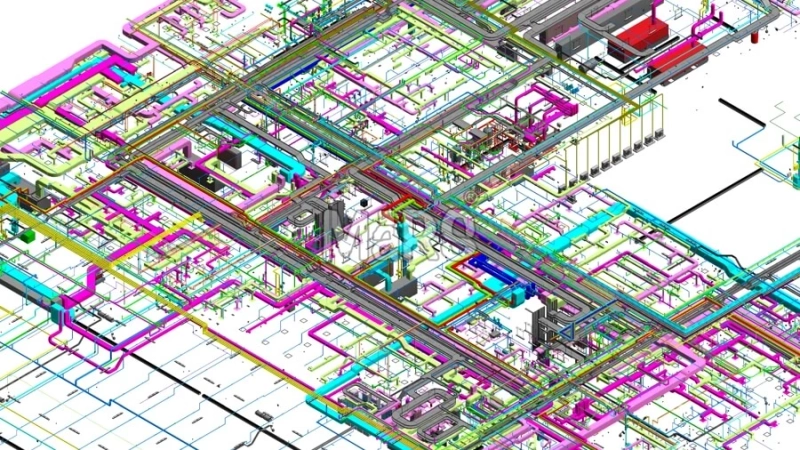In the intricate dance of construction, Mechanical, Electrical, and Plumbing (MEP) systems play a pivotal role. The seamless coordination of these systems is not just a technical necessity; it's an art form that ensures the harmony and functionality of a building. This blog delves into the complexities of MEP coordination, exploring the challenges, strategies, and the artistry required to achieve a symphony of systems in the built environment.
Understanding MEP Coordination the Backbone of Building Design
MEP coordination is the process of harmonizing the mechanical, electrical, and plumbing components of a building to work together seamlessly. It involves the collaboration of architects, engineers, and contractors to ensure that each system is strategically placed, avoiding clashes and conflicts. The goal is to create an integrated and efficient infrastructure that meets the functional needs of the occupants.
The Challenges of MEP Coordination Navigating Complexity
The built environment is a tapestry of diverse systems, each with its own set of intricacies. Coordinating mep services requires addressing challenges such as spatial constraints, conflicting layouts, and the need for efficient routing. The complexity is further intensified by the advancements in technology and the integration of smart building solutions, adding layers of coordination intricacies.
Early Integration in Design Laying the Foundation for Harmony
The key to successful MEP coordination lies in early integration during the design phase. Architects, MEP engineers, and other stakeholders collaborate from the project's inception, ensuring that each system is accounted for in the architectural plans. This proactive approach minimizes the need for costly modifications during the construction phase and sets the stage for a more streamlined execution.
Building Information Modeling (BIM) The Catalyst for Coordination Efficiency
In the digital age, Building Information Modeling (BIM) emerges as a game-changer in MEP coordination. BIM enables a 3D representation of the entire building, allowing stakeholders to visualize and assess the placement of MEP components. This technology facilitates real-time collaboration, clash detection, and accurate documentation, significantly reducing the risk of coordination errors.
Clash Detection and Resolution Nipping Issues in the Bud
Clashes in MEP coordination refer to instances where components of different systems intersect or conflict. Advanced software tools enable clash detection, allowing project teams to identify potential issues before construction begins. Timely resolution of clashes is essential to maintaining the integrity of each system and avoiding costly rework during construction.
Coordination Meetings Facilitating Effective Communication
In the realm of MEP coordination, effective communication is paramount. Regular coordination meetings bring together stakeholders to discuss progress, address challenges, and ensure everyone is on the same page. These meetings serve as a forum for collaboration, allowing teams to share insights, discuss modifications, and collectively work towards the common goal of a harmonious MEP system.
The Role of Project Managers Orchestrating MEP Success
Project managers act as conductors in the symphony of mep services. They oversee the entire process, ensuring that timelines are met, budgets are adhered to, and coordination challenges are addressed promptly. Their role is to orchestrate the collaboration between architects, engineers, contractors, and other specialists, ensuring that each element of the MEP system harmonizes seamlessly.
Technology Integration in MEP Systems from Efficiency to Innovation
Advancements in technology not only impact the coordination process but also contribute to the innovation of MEP systems. Smart technologies, such as IoT sensors and automated controls, are integrated into MEP designs to enhance efficiency, reduce energy consumption, and provide real-time monitoring. Coordination now extends beyond physical placement to ensuring the interoperability of these intelligent systems.
Sustainability in MEP Coordination A Green Harmony
The pursuit of sustainable building practices introduces an additional layer to MEP coordination. Designing for energy efficiency, water conservation, and environmentally friendly practices requires meticulous coordination of sustainable MEP systems. Integrating renewable energy sources, optimizing HVAC systems, and implementing water-saving measures contribute to the green harmony of a building.
Evolving Trends in MEP Coordination Looking to the Future
As technology continues to advance, and sustainability becomes a non-negotiable factor in construction, the trends in mep services are evolving. Prefabrication and modular construction methods are gaining prominence, offering an off-site approach that enhances coordination precision. Augmented reality (AR) and virtual reality (VR) are also emerging tools that provide immersive experiences, allowing stakeholders to visualize MEP systems in unprecedented detail.
Conclusion
In the grand orchestration of construction, mep services stands as a testament to the delicate balance between art and engineering. ENGISOFT ENGINEERING - BIM Staffing & BIM Services from the initial strokes on the architectural canvas to the final installation of systems, the art of coordination ensures that every element contributes to the symphony of a well-functioning, efficient, and sustainable building. As we look to the future, the evolution of technology and a commitment to sustainability will continue to shape the artistry of MEP coordination, creating harmonious environments that stand as landmarks of human ingenuity.


